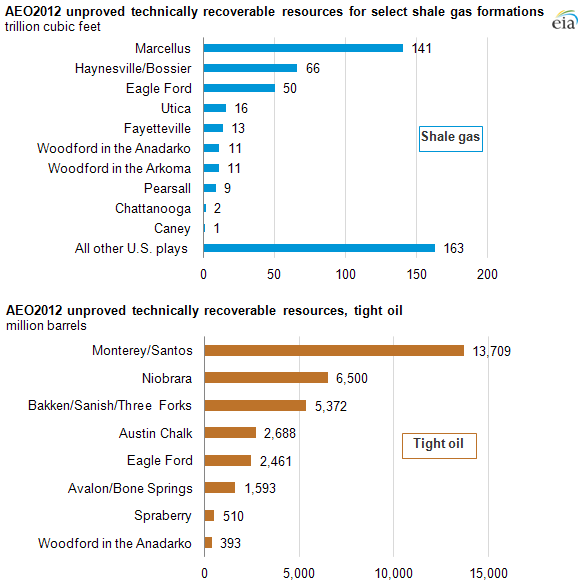
Geology and technology drive estimates of technically recoverable resources

Note: See map for play locations.
A common measure of the long-term viability of U.S. domestic crude oil and natural gas as an energy source is the remaining technically recoverable resource (TRR). TRR estimates are a work in progress, changing as more production experience becomes available and as new technologies are applied to extract these resources. The greatest uncertainty is associated with the "estimated ultimate recovery," or EUR, per well.
EIA updates its TRR estimates using the latest available well production data. EIA's recently released Annual Energy Outlook 2012 (AEO2012) contains a detailed discussion of TRR estimates and resource uncertainty. AEO2012 projections also include sensitivity cases varying the EUR per well and a high-TRR case. The TRR estimates provide context for the size of the resource, while projected production depends strongly on the number of wells, the EUR per well, other well characteristics, and economics.
TRR estimates consist of "proved reserves" and "unproved resources." As wells are drilled and field equipment is installed and productivity is assumed, unproved resources become proved reserves and, ultimately, production. The TRR estimate for a continuous-type shale gas or tight oil area is the product of land area, well spacing (wells per square mile), percentage of area untested, percentage of area with potential, and the estimated ultimate recovery (EUR) per well.
The Annual Energy Outlook 2012 unproved TRRs are shown in the figures above for the major shale gas and tight oil formations. The formation parameters that result in these TRR are provided elsewhere. The volume of total TRR due to proved reserves is not shown. "Tight oil" refers to crude oil and condensates that are produced from low permeability sandstone, carbonate, and shale formations. The tight oil TRRs are for the entire formation, including the non-shale portions.
Whenever possible, EIA uses the formation parameters (e.g., land area, well spacing, etc.) developed by the U.S. Geological Survey (USGS) and published in their oil and gas resource assessments. When the USGS parameters for a formation are not available, the EIA will use other public data, such as that provided by the State geologic surveys, professional societies, and production data providers. In order to capture the productive variability across a formation, the largest formations are subdivided into subplays—first across States (if applicable), and then into three productivity categories: best, average, and below average.
Although each TRR parameter has some degree of uncertainty associated with it, the greatest uncertainty is associated with the determination of a formation's or subplay's average EUR per well. A well's EUR equals its cumulative production over a 30-year productive life, using current technology without consideration of economic or operating conditions. In order to determine a well's EUR, its monthly production profile is statistically fitted to a hyperbolic decline curve so that the well's production profile can be extrapolated into the future for its full 30-year lifetime.
Variability in well production causes considerable uncertainty around a formation's average EUR. Neighboring well production rates can vary by as much as a factor of 3, while well production rates across the entire formation can vary by a factor of 10. This variability is due to the significant local variations in formation depth, thickness, porosity, carbon content, pore pressure, clay content, thermal maturity, and water content. The productive variability across a formation's wells complicates the development of EUR estimates because it is not clear which wells within a formation are truly representative of that formation.
The uncertainties in determining well EURs are further compounded by the following factors:
- Most shale gas and tight oil wells are only a few years old, and their long-term productivity is untested. Consequently, reliable data on long-term production profiles and long-term well recovery rates are lacking.
- In newly developed formations, production has been confined largely to "sweet spots" that have the highest known production rates for the formation. "Sweet spot" is an industry term for those select and limited areas within a shale or tight play where the well EURs are significantly greater than the rest of the play. When the production rates for the sweet spot are used to infer the productive potential of an entire formation, its resource potential may be overestimated.
- Many shale formations (e.g., the Marcellus shale) are so large that only a portion of the formation has been extensively production-tested.
- Future technical advances could lead to more productive well designs with higher EURs.
The issue of technological progress complicates EUR assessments because the continual improvement in drilling and completion techniques has significantly improved initial well production rates and possibly their long-term EURs. Because of the continual improvement in technology, it is not clear whether the production profiles of the older wells within a formation are representative of future well productivity. In certain instances it is appropriate to exclude some of the older well production data in creating a EUR estimate because the technology embodied in those wells is no longer representative of the wells that are likely to be drilled and completed in the future.
Over time, estimates regarding a formation's average EUR should become less uncertain as more wells are drilled across the entire formation and as more wells produce over a longer period of time. As a formation's EUR estimate changes, so too will the formation's TRR estimate. Consequently, TRR estimates are a work in progress, changing as more production experience becomes available and as new technologies are applied for extracting these resources.